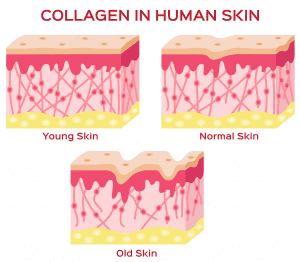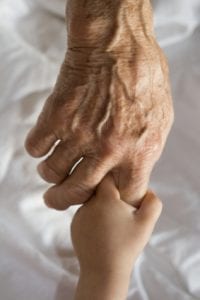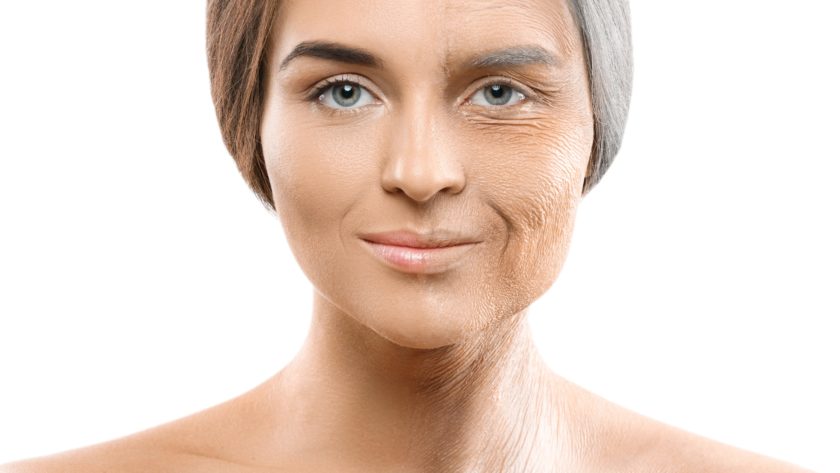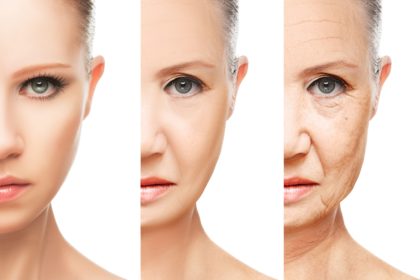“Normal” Aging

The skin is the largest organ of the body and one of the most revealing places where aging occurs. Over time, your skin may lose its original ‘snug fit’ and begin to wrinkle and sag due to the following age-related changes:
- Collagen cells break down. Collagen is the main protein of connective tissue that provides strength to the skin – as well as to blood vessels, cartilage, ligaments, tendons, and bone.
- Muscles beneath the skin atrophy (diminish and shrink).
- Bones shrink away from the skin due to bone loss.
- Subcutaneous cushion of fat diminishes. As a result:
- Cheeks and eye sockets become hollowed.
- Hands and neck lose firmness.
- Bones become more visible.
- Underlying small blood vessels are readily broken upon impact (skin bruises easily).
- Body becomes at risk for hypothermia due to loss of natural insulation.

- Elasticity (the ability to stretch and rebound) diminishes. Fibrous connective tissue (elastic tissue) loses specialized cells called elastin fibers. In young skin, these fibers can be stretched and tend to return to their original length. The ‘elastic rebound test’ (below) is a good measure of skin elasticity.

Elastic Rebound Test – Gently take a pinch of skin between your thumb and forefinger (on the back of your hand), raise it 1/4″ above the surface into a little ridge, hold for 5 seconds, then let go. If the ridge completely flattens out in:
- Less than 2 seconds or instantaneously = Your skin is very elastic and youthful.
- 2 seconds or more = Your skin is probably that of someone in their 50s or 60s.
- 6-7 seconds = Your skin is probably that of someone in their 70s.
Other Age-Related Changes That Occur in Skin

Skin becomes thinner with age revealing veins, muscles, and tendons Epidermis (outermost protective layer of skin) and dermis (the second deeper layer) become thinner. This thinning causes the skin to look less substantial and more ‘transparent’ allowing veins, tendons, and muscles to show through. Epidermal thickness (limb and trunk) of a 20-year-old decreases by 20-29% by age 70. Epidermal cells also shrink in size.
- Sweat glands diminish in size and secrete less sweat. The ability to sweat sufficiently and cool the skin decreases (diminished thermoregulatory ability) causing the body to become at risk for developing heat stroke or heat exhaustion.
- Sebaceous glands, which secrete sebum (oil) that lubricates the skin, become less active in women after menopause. Reduction in oil causes the skin to become dry, scaly, and possibly itchy.
- Number of melanocytes (pigment cells) decrease by 10-20% per decade. The remaining pigment cells tend to get bigger and group together causing irregular-shaped, dark patches of skin known as age spots (a.k.a. liver spots) that commonly appear on aged skin.
- Speed and efficiency in healing and recovering from minor nicks, cuts, and trauma decreases. Growth factors begin to diminish which cause aging. Older skin may take 4-5x longer to heal than younger skin.
- Ability to shed dead skin cells readily and to quickly regenerate new skin cells diminishes resulting in dull, grayish skin.
![]() Karen’s Fit Tip: As scientists study everyday metabolic activities that promote DNA damage and cellular breakdowns, their contributions have been responsible for understanding why we age and for the remarkable increase in the human life. span.
Karen’s Fit Tip: As scientists study everyday metabolic activities that promote DNA damage and cellular breakdowns, their contributions have been responsible for understanding why we age and for the remarkable increase in the human life. span.





